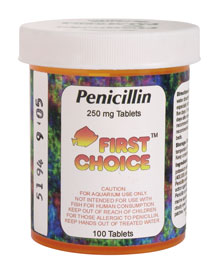|
Rotten Library > Medicine > Superbugs
Superbugsaka Resistant Disease You worry about what's going to kill us all. You worry about chemical weapons, biological weapons, nuclear weapons... Will Osama bin Laden lead an army of crazy terrorists to kill us? Will North Korea spark an atomic cataclysm?
You worry about what's going to kill us all. You worry about chemical weapons, biological weapons, nuclear weapons... Will Osama bin Laden lead an army of crazy terrorists to kill us? Will North Korea spark an atomic cataclysm?Forget all that. You want to know what's going to kill us all? Penicillin. Because of the rampant misuse of antibiotics and antiviral medications, bacteria and viruses are evolving into superbugs. The next time someone tries to tell you there's no such thing as evolution, tell them about drug-resistant staph. Survival of the fittest is alive and well in the world. And you're not the fittest, in case you were wondering. Here's how it works. For decades, doctors routinely prescribed antibiotics like penicillin for just about any complaint, sometimes even without a real diagnosis. And why not? Germs are germs, and antibiotics kill germs. When you kill germs with antibiotics, however, a few germs survive. The germs that survive are tougher than the germs that were killed. When you use antibiotics all the time, you create evolutionary pressure. The surviving germs reproduce and pass their genes for toughness on to the next generation.
On the bright side, June saves herself a trip to the doctor the next time Beaver gets a sore throat. If June had forced Beaver to keep taking the antibiotic for the whole seven days, it might have killed off the whole infection. But when you stop the antibiotic on Day Four, a pretty fair number of the more resilient germs survive, even when the symptoms have ended. Forty years ago, there were no statistically identifiable strains of drug-resistant streptococcal infection (strep throat). From 1997 to 2002 alone, the number of reported incidents tripled. Germs also evolve to evade antibiotics by reproducing faster and becoming more contagious, becoming more deadly in the process. By 2004, around 40% of life-threatening strep infections (i.e., pneumonia) were estimated to be resistant to at least two antibiotics.
At the same time that the germs are getting tougher, we're getting weaker. Consider myopia. Although there are environmental factors that complicate the issue, the fact is that myopia was a severe impediment to survival 400 years ago. Today, it's increasing at epidemic levels around the industrialized world. Since the commoditization of eyeglasses, myopia no longer disqualifies you from living long enough to reproduce in an urban environment. Although there's a vehement (and boring) argument about whether the primary cause of myopia is genetic or environmental, it's pretty easy to see that there would still be a lot less nearsightedness if 20/20 vision was required in order to survive and reproduce. There might also be a lot fewer people in general, but the ones who survived would have good vision. Evolution cuts both ways. We've been treating diseases with antibiotics for six decades now, three or four generations. The body's natural immune systems are not as crucial to survival as they once were. Instead, we've relied on drug treatments to deal with disease. Our depleted immune systems are now open to further insult, such as the development of diseases that directly target immune response, HIV being the most notable example. Assuming the bugs give us a few more generations before wiping us out entirely, the drugs should stop working completely right about the time that the human immune system reaches its all-time low.
Although we've been doing things wrong for considerably less than a century, there's a huge disparity in the evolutionary speed of humans vs. germs. Because humans are so complex and because a generation of humans takes 15-20 years to reach optimum reproduction age, it takes a lot longer for evolutionary progressions to take place on a systemic basis (devolution is faster because the genes for inferior traits like nearsightedness already exist in the population). In contrast, germs measure their generations in minutes. Strep and staph, two of the most common bacteria, can produce multiple generations with a matter of hours. That means 20,000 or 50,000 generations of strep are produced for every one human generation. Bacteria also mutate much more easily than humans. So what's the bright side? Well, some humans are smart enough to figure out that this problem exists. Hopefully, those humans are smart enough to figure out solutions as well. Right now, the best solutions are only slowing the problem. Tactics in the war on bugs include:
So far, these tactics have not been strikingly effective. The problem is that resistance is already in the gene pool out there in the real world. It's great that we're slowing the development of new forms of resistant diseases, but Pandora's Box doesn't close so easily. Additionally, some diseases are simply adapting to the above tactics. Because there isn't a treatment that can purge your body completely of HIV, the AIDS virus is particularly effective at evolving new and dangerous strains that are resistant to drug cocktails and rotating treatments. Recent reports also suggest that HIV may be evolving into a more deadly and faster-spreading form, but it's a little early to panic on that front yet. Fortunately for us all, nature does have a way of correcting itself in these situations. Unfortunately, that way is known as an epidemic. When a disease evolves into a sufficiently deadly and contagious strain, it rips through a population, killing off the weak and ensuring that the strong survive and pass their genes to the next generation. We haven't reached that stage. Yet. We might avoid it, if we're clever enough. At the moment, however, the smart money is probably on the bugs.
|
 The problem was worsened by well-meaning parents from the '50s through the '90s. June Cleaver gets a penicillin prescription for young Beaver's
The problem was worsened by well-meaning parents from the '50s through the '90s. June Cleaver gets a penicillin prescription for young Beaver's  And it's not just bacterial infections, either. Consider HIV, the
And it's not just bacterial infections, either. Consider HIV, the 